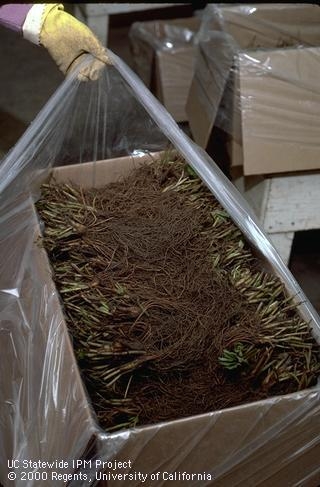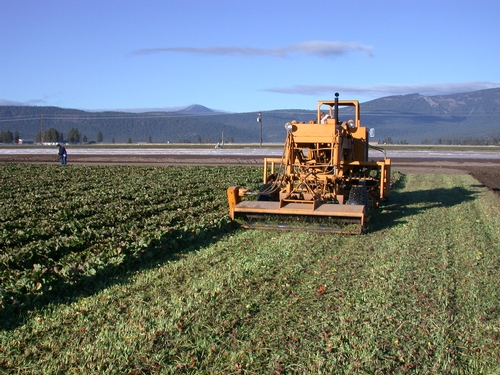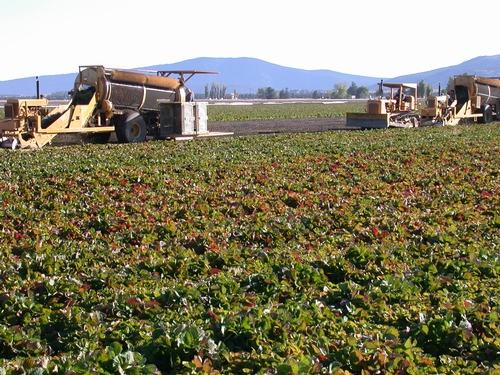Posts Tagged: Monterey
Modifying the Nutritional Guidelines for Nitrogen for the Strawberry Variety ‘Monterey'
The question has come up more than a few times from industry participants on how to adjust nitrogen (N) inputs for strawberry varieties more productive and of larger plant size than Albion for which the original DRIS study was done.
Simple math says one could just increase simply N uptake estimate to cover the added fruit and bigger plant, so if Monterey produces 20% more fruit, and is that much larger a plant, one just adds 20% more nitrogen to the standard annual fertility program to make up the difference. However, as simple as this math may seem, it could quite possibly be incorrect, since it is not at all unknown that different strawberry varieties have variations in N content in the fruit and leaves.
The work to determine N content of Monterey compared to that of Albion was done over two samplings (one in early May, the other mid-July) of five fields of Albion and five fields of Monterey. We found that Monterey had marginally higher N concentrations in both the leaves (Table 1) and the fruit (Table 2) on both sample dates. An evaluation of plant size, without fruit, found that Monterey also ran about 20% larger than Albion from the five fields sampled.
From this information, we can say that N uptake is at least as high in Monterey as in Albion per unit of plant growth. That is to say, if a grower expects and has experienced 20-25% increases in fruit yield with Monterey over that of Albion, then the amount of N uptake to support that level of productivity will also be 20-25% higher than for Albion.
We need to be careful here however. This is not a call for growers of Monterey to automatically increase their N fertilizer additions by 25%. If a grower is finding his or her seasonal practices in the lower half of typical grower practice, then an increase in nitrogen application could be tested, but if a grower is already using a lot of N, say above 250 lbs per acre, then that might be enough to absorb the higher N requirement of Monterey.
Table 1: Nitrogen (N) concentrations in dry leaves
|
Variety |
4-5 May |
12-15 July |
|
Monterey |
3.02 % |
2.71 % |
|
Albion |
2.81 % |
2.44 % |
Table 2: Nitrogen (N) concentrations in dried fruit
|
Variety |
4-5 May |
12-15 July |
|
Monterey |
1.28 % |
1.06 % |
|
Albion |
1.22 % |
0.93 % |
Many thanks to the growers who participated in this study, and generously allowed me to tear plants out of their fields for the plant size sampling.
Review of Chill for the UC Day Neutral Strawberry Varieties Albion, San Andreas and Monterey
I had a conversation quite recently with Doug Shaw, UC plant breeder, concerning the concept of chill in the day neutral varieties and the desire of some Central Coast growers to reduce the recommended amounts significantly, even all the way down to zero days of chill:
In the way of review, please recall that chill requirement in strawberry in California is made up of two essential parts. One part is what the plant accumulates in the field before being harvested, and the other is accumulation of chill after harvest and the plant is in storage. There is a big difference between the two and one does not supplant the other. In-field chill takes place when the plant is still in the soil, out in the open and still has all its leaves. Supplemental chill takes place after harvest of the plant and occurs in a constant near freezing temperature, in the dark and the plant has none to very few leaves left (Figure 1 below).
Accumulation of chill, especially supplemental chill, in the strawberry transplant makes it stronger and better able to survive the stress of plant harvest, transplant and the growing season beyond.
As some of the chill sensitivity has been bred out of the modern UC day neutral varieties such as Albion, Monterey and especially San Andreas, it is indeed possible to grow these varieties with less than the recommended amounts (10-18 days) of supplemental chill. However, those who choose to reduce chill below these amounts should recognize the amount of risk they are taking and that this is not an exercise for those still using training wheels. Should growing conditions take a turn for the worse, these underchilled plants do not have the vigor to help them pull through and will suffer more than those adequately chilled. Moreover, while UC day neutral strawberry plants chilled significantly less than the recommended 10-18 days can produce fruit earlier than others (probably owing to the earlier planting date), these plants quite likely will not perform optimally in terms of overall yield and quality along with showing a tendency to produce smaller fruit later on in the season.
The only case where one would want to go short on supplemental chilling time would be if the plant harvest was so late that a minimum chill time of 10 days would result in a planting date so late that it would compromise plant growth and establishment.
Other than that, it is still recommended to give the UC day neutral varieties 10-18 days of supplemental chill.

Trimmed transplants being packaged in box with polyethylene lining, ready for placement into the cooler for supplemental chilling.
A Caution on Supplemental Chill for Several Day Neutral Varieties on the Central Coast
There is a stream of thought currently in the Watsonville- Salinas strawberry production district of gaining advantage with earlier plant establishment this year by dramatically reducing the amount of supplemental chill, which is the cold storage of transplants following harvest, for the day neutral varieties ‘San Andreas’ and ‘Monterey’. This might stem from reports that a number of growers in Santa Maria did well in the 2010-2011 production season with a single day of supplemental chill, and furthermore it is standard for growers in Ventura County to plant ‘San Andreas’ with a single day of chill. For some then, it does not then seem like too much of a reach that this might be a good strategy for the Watsonville- Salinas production district.
This is worth reviewing because it flies in the face of standard recommendations for these two varieties planted in this area. There are several things going on here that perhaps contributed to the ability of some growers in Santa Maria to produce well last year with a single day of chill. First, on average last fall, transplants were harvested 10-14 days later than normal and this spring was cooler than usual, meaning a bit lengthier cold conditioning in the nursery field and less plant stress early in the season. Second, ‘San Andreas’ does seem to be a variety which is affected less by supplemental chill than other varieties, that is to say that it might not need quite as much.
Still, the UC recommendations do not change. UC Davis plant breeder Doug Shaw, who brought all of these varieties into the world and therefore has an abundance of knowledge regarding them, is not changing his recommendations. He maintains that one would want to choose transplant harvest about October 18-20 and plant early November, with two weeks supplemental chill. In all cases, plants should be chilled a bare minimum of eight to ten days.
Never forget that supplemental chill gives the plant vigor to forgive the tough conditions of transplanting. Planting day neutral varieties in the Watsonville Salinas district with one day of chill to gain advantage of earlier plant establishment is very much like picking up pennies in front of a steamroller. For a possible small incremental gain, one is risking total disaster. One day of supplemental chill is NOT recommended for University of California day neutral varieties grown on the Central Coast.

Strawberry transplant stock being mowed for leaf removal

Harvest operation of strawberry transplants. Note purpling and reddening of strawberry leaves in foreground indicating entrance into dormancy.

